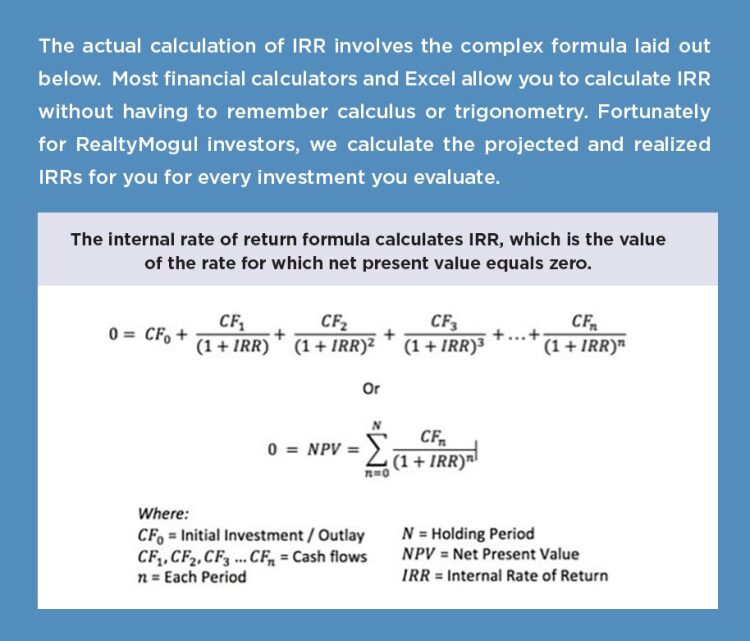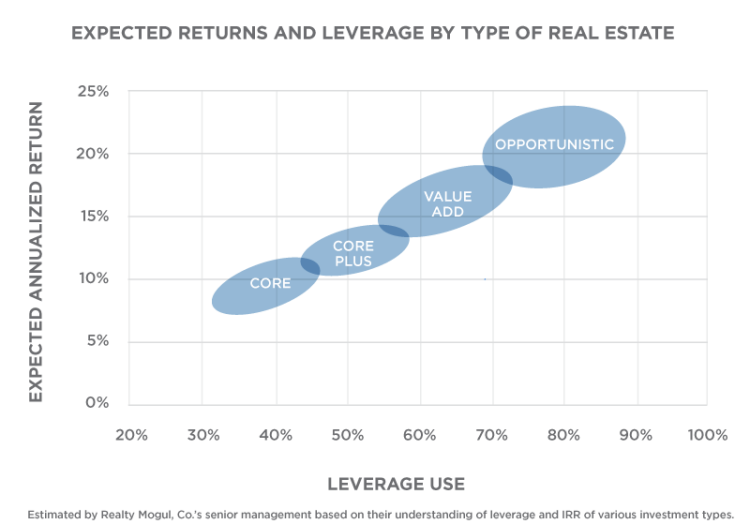Part 3: IRR vs. Cash-on-Cash – Which is More Important for Real Estate Investors?
When deciding whether to invest in a commercial real estate opportunity, there are two main financial metrics that investors focus on: internal rate of return (IRR) and cash-on-cash (CoC). Both of these measures are important, but is one actually more important than the other?
There is no easy answer to this question, as it depends on each investor’s goals, needs, and preferences. IRR is a measure of how profitable an investment is over the entire investment period. It takes into account the initial investment, the final value of the investment, and timing of all the cash flows in between. Conversely, cash-on-cash is a periodic measure of cash flow as a percentage of the cash invested in an opportunity, typically calculated on an average annual basis.
Investors should carefully consider both IRR and cash-on-cash when evaluating a potential investment in commercial real estate. Ultimately, deciding what weight to give each metric as part of the evaluation of investment opportunities will come down to each investor’s objectives and risk tolerance.
Executive Summary
- Many investors use IRR to evaluate commercial real estate investments because it takes into account the time value of money. IRR accounts for the fact that a dollar today is worth more than a dollar in the future.
- Some investors may be more focused on current cash flow and will look to projected cash-on-cash returns because they are seeking to receive regular income from their investment. Others choose properties with low or even no cash flow because they are more interested in capital appreciation.
- Capital preservation, time value of money, and investment time horizon all affect investment strategy. For example, investors with a short investment time horizon may be more interested in preserving or conservatively growing capital than taking greater risk in search of generating greater longer term capital appreciation. Current cash flow is also generally a more conservative approach, because a greater percentage of the overall return comes back to the investor more quickly in the form of periodic distributions.
- The real estate risk-reward spectrum is used to evaluate potential commercial real estate investments. This spectrum ranges from low-risk/low-reward to high-risk/high-reward. Investors must decide how much risk they are willing to take on to achieve their desired return, and over what time horizon they are seeking to invest.
How to Use IRR in Evaluating a Commercial Real Estate Investment
IRR is a metric used by investors to evaluate the potential return on investment (ROI) of a commercial real estate purchase. To calculate IRR, you will need to know the projected cash flows from the investment over its life, including the original investment and the expected net proceeds upon exit. Some investors will then compare the projected IRR for a given project to their own personal minimum required rate of return or “hurdle rate.”
When using IRR to evaluate a commercial real estate investment, it is also important to consider the time value of money. Money has a time-value because it can earn interest and is also subject to inflationary deterioration in value. Money also has an opportunity cost - which is the opportunity to invest that money in something else and potentially earn a higher return.
Investors should also consider their investment time horizon, which is the length of time that an investor intends to invest their capital prior to needing it to fund future needs or expenses. This timeframe (i.e., the length of time before an investor needs their capital returned) may dictate how much risk the investor is willing to take on. For example, investors with a longer time horizon can afford to take on more risk because they have a longer time frame to recover from any losses.
Source: Corporate Finance Institute1
Using IRR in Conjunction with Other Metrics to Get a More Holistic View of a CRE Investment
The IRR is an important metric when assessing the potential profitability of a commercial real estate investment. However, it’s just one piece of the puzzle. Investors also need to consider other factors such as the cash flow, investment objectives and time horizon, and risk profile of the property.
Cash Flow
Investors focus on cash flow for a variety of reasons. One reason is that cash-on-cash is often considered a more reliable metric than internal rate of return (IRR). This is because IRR can be significantly impacted by several subjective factors, such as the projected length of the investment period and assumptions about future exit valuation. CoC, on the other hand, generally has a higher degree of predictability for sponsors, and is actual cash paid to investors during the hold period.
Another reason some investors focus on cash flow is that it gives them a better idea of how much money they will actually receive from the investment. This is important because many commercial real estate investments are not liquid, and the investor may be unable to sell the property quickly if they need to access the money.
There are some drawbacks to focusing on cash flow, however. One is that it can be difficult to predict cash flows accurately, especially over the long term. Another drawback of focusing on cash flow is that it does not consider the time value of money.
Lower Projected Cash-on-Cash, but Higher Projected IRR
For several reasons, some investors may choose to invest in a commercial real estate project with low or even no cash flows prior to the exit, but with a higher projected IRR.
First, the investor may believe that the property will appreciate over time, providing them with a capital gain when they sell it. Second, the investor may be able to take advantage of tax benefits in the early years of the investment when the associated commercial real estate investment is generating losses. Finally, investment opportunities with low or no cash flow can potentially provide higher overall IRR returns, as investors require higher returns as compensation for delaying cash flows or distributions and the greater execution risk.
Of course, there are also some potential drawbacks to consider. For one thing, it can be riskier investing in a project that does generate cash flow since there is no guarantee that the property will increase in value as planned. Additionally, there’s always the possibility that something unforeseen could happen during the construction or operation of the property that affects the exit strategy and the projected IRR. Opportunistic investments in real estate like ground-up development, for example, arguably carry a heavier burden of construction and execution risk than more stabilized cash flowing properties.
Personal Investment Strategy
Wealth building, income creation, and wealth preservation are all important concepts for investors. Each one has different implications in terms of how an investor should approach his or her investment strategy:
- Capital preservation is the most conservative of the three approaches. The goal of capital preservation is to protect the original investment capital from any losses. This approach is typically taken by investors with a low risk tolerance or who are nearing retirement and want to preserve their nest egg.
- Income creation seeks to generate ongoing cash flow from one’s investment. The goal is to generate an ongoing return from one’s investment. This approach is typically taken by investors with a medium risk tolerance who are seeking recurring cash flow from their investment
- Wealth building has the potential for the highest return and therefore is the riskiest approach. The goal of wealth building is to grow the capital invested in the real estate transaction to generate capital gains. This approach is typically taken by investors with a longer-term time horizon and a higher risk tolerance.
Each investor will have different goals and objectives when it comes to wealth building, income creation, and wealth preservation. However, understanding these concepts is essential to make informed investment decisions.
How to Compare Risk-Adjusted Returns Across Different Investments
Risk and return are not always perfectly correlated in the world of private real estate. In fact, one advantage of private real estate is that the market is generally not as efficient as some other public markets, such as publicly traded stocks and bonds. This means that there can be opportunities for investors to find properties with higher returns relative to the level of risk.
The real estate risk-reward spectrum is used to assess the potential risks and rewards associated with different types of real estate equity investments. The spectrum ranges from core investments, which typically offer the lowest amount of risk, but also the lowest returns, to opportunistic investments, which typically offer the highest potential returns, but also likely to present the highest potential risk.
Core-Plus investments, such as properties in prime locations or well-maintained buildings, fall somewhere in the middle of the risk-reward spectrum. These investments offer moderate risks and returns, making them a good option for investors looking for stability and consistent income. Core-Plus investments also typically have lower leverage which further corresponds with lower overall risk oftentimes in exchange for lower conservative returns. Core investors typically target an 8-11% IRR and Core-Plus investors frequently target an 11-14% IRR, both of which may also be associated with more predictable cash-on-cash returns.
Value-add, opportunistic and ground-up development investments are at the higher end of the risk spectrum, but they also typically have the potential to generate somewhat higher returns. These types of investments may be more suitable for investors willing to take on additional risk to achieve potentially greater rewards.
The level of risk and potential reward associated with a particular real estate investment may also vary depending on a number of factors, including the property’s location, age and the contemplated business plan. For example, a value-add project in a small tertiary market with an inexperienced operator likely presents higher risks than a very similar project in a large primary real estate market with an experienced operator targeting similar returns.
Learn More
If you are an investor looking to invest in real estate, take a look at RealtyMogul. It is one of the most comprehensive and user-friendly real estate investing platforms and offers investment opportunities in many types of properties, such as multifamily buildings, industrial properties, office buildings, retail centers, and REITs.
RealtyMogul’s broad range of commercial real estate passive investment offerings enables investors to take advantage of opportunities during periods of economic uncertainty. This allows investors to build portfolios that match their personal risk profile. Additionally, with investment minimums that permit diversification, members can passively invest in high-quality, large-scale commercial real estate projects.
This article is for informational purposes only and is not a recommendation or offer to buy or sell securities. Information herein may include forward looking statements and is for informational purposes only. Forward-looking statements, hypothetical information, or calculations, financial estimates and targeted returns are inherently uncertain. Past performance is not indicative of future performance. None of the opinions expressed are the opinions of RealtyMogul. Advice from a securities professional is strongly advised, and we recommend that you consult with a financial advisor, attorney, accountant, and any other professional that can help you to understand and assess the risks and tax consequences associated with any real estate investment.
1https://corporatefinanceinstitute.com/resources/knowledge/finance/internal-rate-return-irr/




